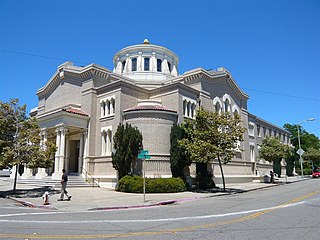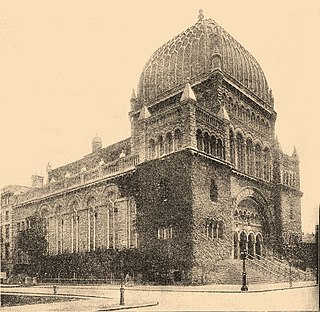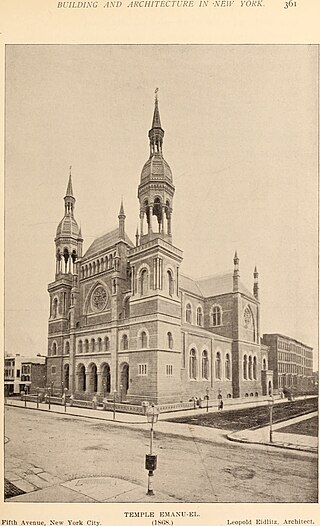
David Einhorn was a German rabbi and leader of Reform Judaism in the United States. In 1855, he became the first rabbi of the Har Sinai Congregation in Baltimore, the oldest Jewish-American congregation affiliated with the Reform movement since its inception. While there, he created an early American prayer book for the congregation that became one of the progenitors of the 1894 Union Prayer Book.

Rodef Shalom Congregation is an historic Reform Jewish congregation and synagogue located at 4905 Fifth Avenue, Pittsburgh, Pennsylvania, in the United States. The landmark building was designed by architect Henry Hornbostel and completed in the Beaux-Arts style.
Temple Emanu-El is a Reform Jewish synagogue located at 8500 Hillcrest Road, in Dallas, Texas, in the United States. Chartered as the Jewish Congregation Emanu-El in 1875, it was the first Reform congregation in North Texas, and is the largest synagogue in the South.
The Rockdale Temple, formally Kahal Kadosh Bene Israel, is an Ashkenazi Reform Jewish congregation and synagogue, located in Amberley Village, a suburb of Cincinnati, Ohio, in the United States. Founded in 1824, it is the oldest Jewish congregation west of the Allegheny Mountains, the oldest congregation in Ohio, the second oldest Ashkenazi congregation in the United States and one of the oldest synagogues in the United States.

Temple Emanu-El of West Essex is a former Reform Jewish congregation and synagogue that was located at 264 West Northfield Road, in Livingston, in the West Essex section of New Jersey, in the United States. Founded in 1955, the congregation merged with Temple Sinai in Summit in 2018, due to financial reasons.

Levi Arthur Olan was an American Reform Jewish rabbi, liberal social activist, author, and professor. Born in Ukraine in 1903, he grew up in Rochester, New York and was ordained at Hebrew Union College in 1929. He served as rabbi of Temple Emanuel in Worcester, Massachusetts from 1929 to 1948, and Temple Emanu-El in Dallas, Texas from 1948 to his retirement in 1970. Olan was one of the most prominent liberal voices in Dallas, which was a predominantly conservative city. His views on poverty, war, civil rights, civil liberties and other topics were disseminated largely through his popular program on WFAA radio, and earned him the moniker, “the conscience of Dallas.” He also had a longstanding visiting professorship at Southern Methodist University and published numerous works on Judaism, process theology, and contemporary social issues.

Temple Beth El is a Reform synagogue located at in Bloomfield Township, Oakland County, Michigan, in the United States. Beth El was founded in 1850 in the city of Detroit, and is the oldest Jewish congregation in Michigan. Temple Beth El was a founding member of the Union for Reform Judaism in 1873, and hosted the meeting in 1889 during which the Central Conference of American Rabbis was established.

Temple Sinai is a Reform Jewish congregation and synagogue located at 2808 Summit Street in Oakland, California, in the United States. Founded in 1875, it is the oldest Jewish congregation in the East San Francisco Bay region.
Congregation Beth Israel is an egalitarian Conservative synagogue located at 989 West 28th Avenue in Vancouver, British Columbia. It was founded in 1925, but did not formally incorporate until 1932. Its first rabbi was Ben Zion Bokser, hired that year. He was succeeded the following year by Samuel Cass (1933–1941). Other rabbis included David Kogen (1946–1955), Bert Woythaler (1956–1963), and Wilfred Solomon, who served for decades starting in 1964.
Beth Israel Congregation is a Reform Jewish congregation and synagogue located at 5315 Old Canton Road in Jackson, Mississippi, in the United States. Organized in 1860 by Jews of German background, it is the only Jewish synagogue in Jackson. Beth Israel built the first synagogue in Mississippi in 1867, and, after it burned down, its 1874 replacement was at one time the oldest religious building in Jackson.
Congregation Beth Israel is a Jewish congregation and synagogue located at 411 South Eighth Street, in Lebanon, Pennsylvania, in the United States. Founded in 1907 to provide services for the High Holidays, it was then, and remains today, the only synagogue in the Lebanon area.
Congregation Am Tikvah is a combined Conservative and Reform Jewish congregation and synagogue located at 625 Brotherhood Way in San Francisco, California, in the United States. The congregation was formed in 2021 as the result of the merger of the Conservative B'nai Emunah and the Reform Beth Israel Judea congregations, with the latter formed in 1969 through a merger of the Conservative Congregation Beth Israel and the Reform Temple Judea. The congregation is affiliated with both the Union for Reform Judaism and the United Synagogue of Conservative Judaism.

Temple Emanu-El-Beth Sholom, Westmount is a Reform synagogue in Westmount, Quebec. The syngagoue is the oldest Liberal or Reform synagogue in Canada, incorporated on March 30, 1883, and is the only Reform congregation in Quebec.

Samuel Schulman was an American rabbi.

The Jewish community of Houston, Texas has grown and thrived since the 1800s. As of 2008, Jews lived in many Houston neighborhoods and Meyerland is the center of the Jewish community in the area.

Temple Beth-El was a Reform Jewish congregation and synagogue located at 945 Fifth Avenue and 76th Street in the Upper East Side of Manhattan in New York City, New York, in the United States. The synagogue operated between 1891 until c. 1929, and was demolished in 1947. The Temple Beth-El congregation merged with Congregation Emanu-El of New York in 1927.

Temple Emanu-El was a large Reform Jewish synagogue located on Fifth Avenue and 43rd Street in Midtown Manhattan, New York City, New York, in the United States. Built in 1868, it was demolished in 1927.
Maurice H. Harris served as rabbi of Temple Israel of Harlem for almost fifty years.
Solomon Marcuse Stroock was a Jewish-American lawyer from New York.
Samuel Harry Goldenson was a Polish-born American rabbi.
















